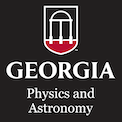Dr. Robin Shelton will be hosting Dr. Sean Brittain of the University of Clemson Department of Physics and Astronomy this week. His talk is entitled " Disks: Catching Planet Formation in the Act?"
High-resolution spectroscopy of warm molecules provides an excellent view of the distribution of gas in disks and complements studies of the dusty content and structure of disks emerging from mid-infrared ground-based instruments and Spitzer. As the planet-forming region of disks is generally spatially unresolved, high-resolution spectroscopy becomes a surrogate by spectrally resolving the velocity of gas. CO in particular is well suited to probing the inner, planet-forming regions of disks because it is relatively stable and becomes self-shielding at low column densities. In this talk we will discuss how the observation of ro-vibrational CO emission can be used to measure the distribution of gas in disks and complement what we learn about the disk from its spectral energy distribution.
The differences in the spectral energy distribution of young stars have led to the suggestion that they reflect an evolutionary sequence from optically thick disks to transitional disks (i.e. disks with optically thick outer disks and optically thin inner disks) to optically thin disks. The canonical interpretation of the morphology of transitional disks is that they reflect dynamical sculpting by an embedded planet. If so, then optically thick disks transition into optically thin disks on the timescale over which planet formation is thought to occur. As intriguing as this possibility is, there are other physical effect—namely grain growth and photo-evaporation—that can give rise to transitional disks with similar spectral energy distributions (Fig. 1). In this talk we describe how these effects can be differentiated by measuring the distribution of warm gas in the disk around Herbig Ae/Be stars using high-resolution spectra of ro-vibrational CO transitions. We will show examples of spectra of several transitional Herbig Ae/Be stars and discuss what this tell us about the morphology of the spectral energy distribution. We will also discuss how these observations can be used to elucidate the geometry of disks, test model predictions of disk heating and shed light on dust settling.


